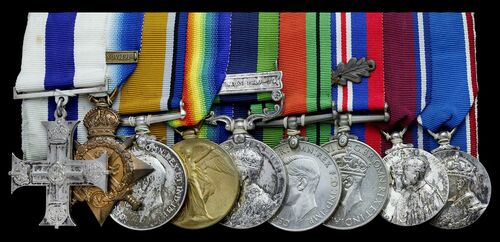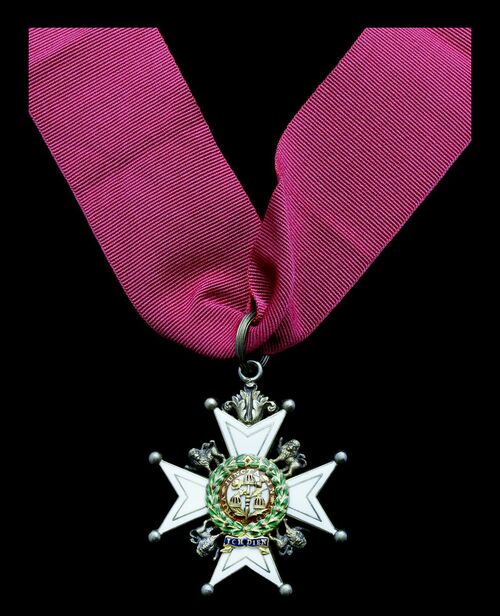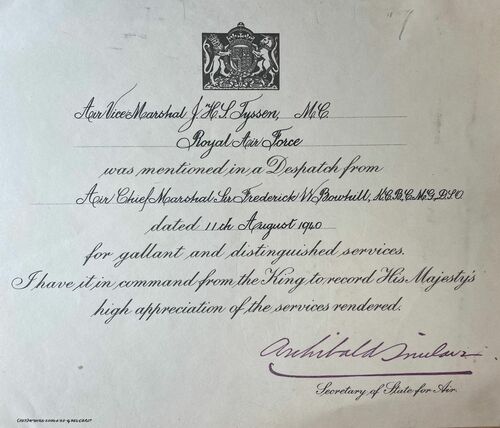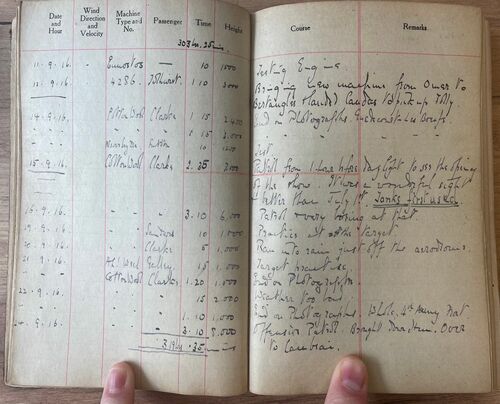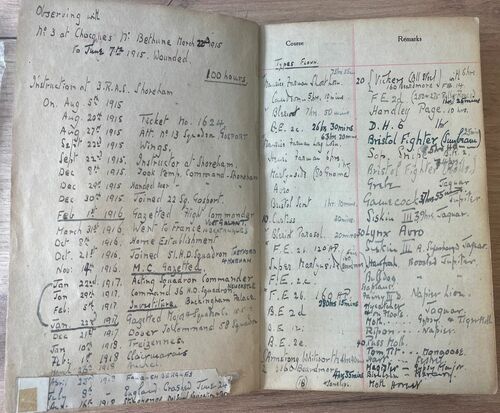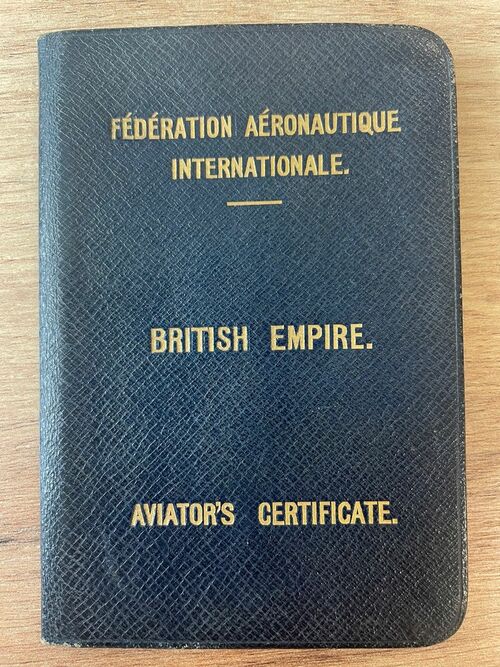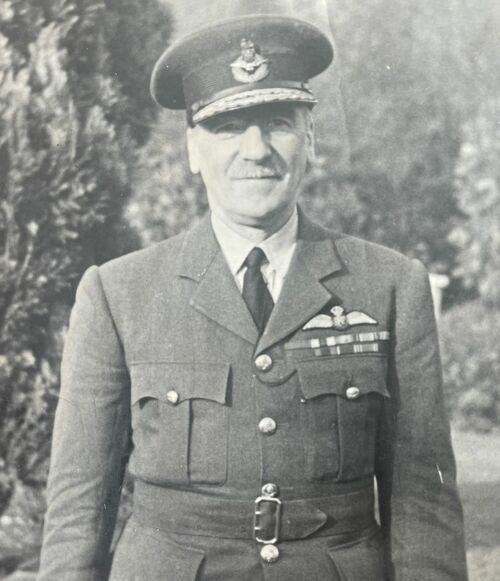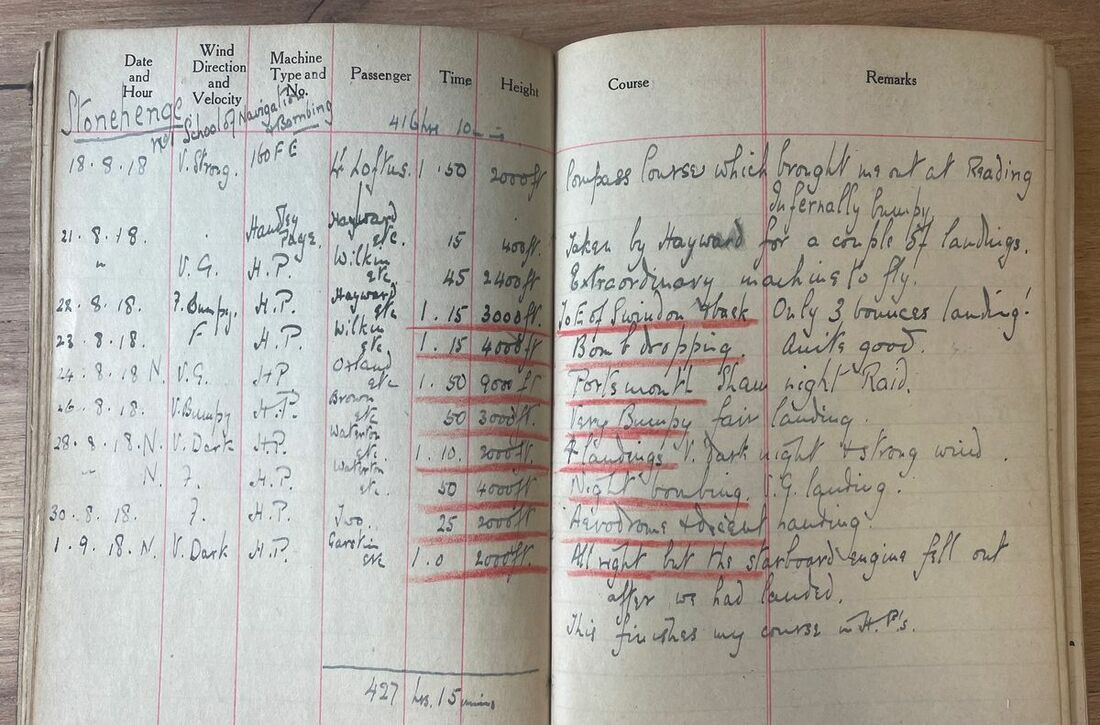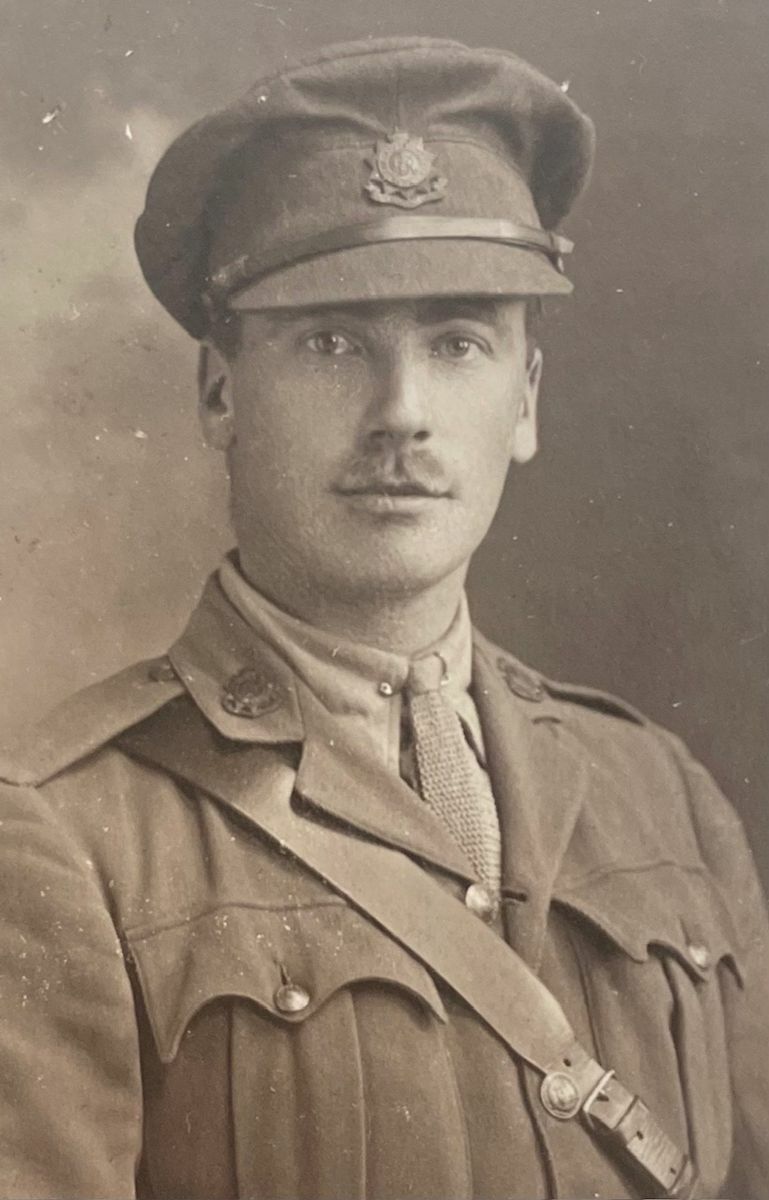Auction: 24002 - Orders, Decorations and Medals
Lot: 251
A fine Second World War C.B., Somme 1916 M.C. group of ten awarded to Air Vice-Marshal J. H. S. Tyssen, Royal Air Force, late North Somerset Yeomanry and Royal Flying Corps
Wounded in action as an Observer in 3 Squadron in May 1915, Tyssen qualified as a pilot on his recovery and saw much action as a Flight Commander in 22 Squadron during 1916, witnessing the First Day of the Battle of the Somme and the first use of tanks on the battlefield - at Flers-Courcellete - on 15 September 1916: 'a wonderful sight, better than 1st July'
Having then had occasion to record 28 holes in his fuselage and a damaged petrol tank - 'Never known Archie so good' - he commanded 58 Squadron in France in 1918 and 20 Squadron on the North-West Frontier 1920-23, prior to holding senior command as A.O.C. in Iraq and in the Second World War
The Most Honourable Order of the Bath, C.B. (Military) Companion's neck Badge, silver-gilt and enamel; Military Cross, G.V.R., the reverse engraved 'Capt. J. H. S. Tyssen. R.F.C. Photography. The Somme 1916. North Somerset Yeomanry'; 1914 Star, clasp (Capt: J. H. S. Tyssen. N. Som: Yeo.); British War and Victory Medals (Major J. H. S. Tyssen. R.A.F.); India General Service 1908-35, 1 clasp, Waziristan 1919-21 (S./L. J. H. S. Tyssen. R.A.F.); Defence and War Medals 1939-45, with M.I.D. oak leaf; Jubilee 1935; Coronation 1937, where applicable, mounted court-style as worn, minor enamel damage to the first, nearly very fine and better (10)
Provenance:
Group Captain F. Newall Collection, Christie's, March 1988.
C.B. London Gazette 24 September 1941:
'In recognition of distinguished services rendered in operational commands of the Royal Air Force during the period 1 October 1940 to 31 March 1941.'
M.C. London Gazette 14 November 1916:
'For conspicuous skill and gallantry. He has done fine work in photography, often fighting against odds in order to get his work done. On one occasion, when five enemy machines interfered with our patrol, he, with another officer, dived at one and brought it down.'
The original recommendation - which adds further details - states:
'For conspicuous skill and gallantry. Captain Tyssen has been exceptionally successful in photography, after fighting against odds to get his work done. On September 24th, five hostile machines interfered with out patrol. Captain Tyssen with Lieutenant Clarke dived at one, firing both guns, and brought it down near the Bois de Gougeaucourt.'
John Hugh Samuel Tyssen was born at Charlton Henbury, near Bristol, Gloucestershire on 20 June 1889 and was educated at Wellington College.
Commissioned in the 3rd (Volunteer) Battalion of the Somerset Light Infantry in June 1907, he afterwards transferred to the North Somerset Yeomanry and was advanced to Captain in August 1914, in which capacity he was embarked for France that November.
Observer - No. 3 Squadron
A month or two later, he was seconded to the Royal Flying Corps and was posted as an Observer to No. 3 Squadron at Choques, near Bethune in March 1915. And between then and June 1915 he amassed 100 hours of flying in the Squadron's 'hotchpotch' selection of aircraft. On 5 May 1915, with Captain G. F. Pretyman as his pilot - see Lot 252 - he helped force down an enemy two-seater near Lille. The relevant combat report states that they were on a reconnaissance in their Morane L, flying at 5,000 feet, when they met a 'Fokker (or Morane) Parasol … clearly marked with black crosses' and 'more silvery in colour than our Moranes':
'Hostile machine sighted over Don, was chased and gradually overhauled. Opened fire at 100x. After about 20 or 30 rounds the Fokker dived vertically underneath our machine. Captain Tyssen last saw it still going down over a ploughed field near Lille. Further observation was impossible owing to anti-aircraft fire.'
Wounded by shrapnel in another patrol on 29 May, Tyssen elected to commence pilot training on his recovery. Hence his appointment to 3 Reserve Air Squadron in August 1915, when he undertook just 4 hours and 45 minutes of basic instruction before qualifying for his Royal Aero Club Aviator's Certificate (No. 1624) on the 20th. Further training ensued with No. 13 Squadron at Gosport and he was appointed Flying Officer in September 1915.
Flight Commander - No. 22 Squadron
In December 1915, Tyssen was posted to No. 22 Squadron, in which capacity he crossed over to France as a newly appointed Flight Commander in March 1916. Initially based at Vert Galand, but later at Bertangles, the Squadron undertook vital reconnaissance work, locating ammunition dumps, railheads and camps behind enemy lines. Tyssen's flying log book likewise bears testament to constant photographic work on the Somme - over such famous landmarks as Delville Wood, High Wood and Guillemont - including the first day of the battle itself, when he noted 'Patrol & watched the intense … infantry attack'.
Nor was it long before he also noted, 'Never known Archie so good', for enemy opposition was intense throughout. A case in point would be a Flers-Somme patrol flown on 26 April 1916, when 'Archie shot away the bottom of the auxiliary petrol tank'; likewise, another flown on 25 May 1916, when 'properly hotted by Archie (28 holes)'.
Tyssen also fought his fair share of air-to-air combats, including the following encounter on 25 August 1916:
'While on patrol at 8,500 feet over Combles we saw 2 H.A. flying over Guedecourt towards Flers at 4,500 feet. We dived on them and got on to the tail of one, firing a drum at about 80 yards. We then had the main petrol tank hit. We turned towards the H.A. and fired again just about at 50 yards range. Tracers were seen to enter the machine. One engine stopped and we turned West, crossing the lines at 3,000 feet and landed.'
And on 24 September 1916, the combat which featured in his M.C. citation:
'While on offensive patrol at 4.30 p.m. five H.A. (Type E) were encountered over Bus. Lt. Robarts and 2/Lt. Williams attacked one H.A. and it went down in a steep spiral and crashed at D.2. Central. This machine was seen to have one set of planes, crashed and was just at the edge of the road. It looked as if it had crashed into telegraph poles or wires. The crosses on the undamaged planes were clearly visible. Time 4.30 p.m.
At the same time one Roland was attacked by four other F.E.'s and was seen to go down in a vertical dive by all the pilots and observers, obviously out of control. At 4.35 p.m. one H.A. of the same flock was noticed all alone. Capt. Tyssen and Lt. Clarke dived at him firing both guns. The H.A. went through the clouds in a vertical dive and was seen again through a gap still diving and very close to the ground. Both pilot and observer were sure that the machine was out of control, but they did not actually see it crash.
At. 5.30 p.m. Lt. Robarts and 2/Lt. Williams attacked a H.A. (Type E) over the Wood St. Pierre Vaast, firing one and a half drums. It dived and then got into a steep spiral. They could not follow it to the ground. Later they saw a H.A. apparently upside down... which very probably was the same machine.'
This action is also noted in by H. A. Jones in his official history, The War in the Air:
'Five FE's of 22 Squadron were fighting an equal enemy formation at the same time over Bus, south of Bertincourt with greater success. Without loss to themselves they shot down one which crashed into a telegraph line, another which fell and overturned near the wood of St. Pierre Vaast and two others were seen in steep dives close to the ground.'
Other notable patrols carried out by Tyssen over the Somme in 1916 included his observation of the first use of tanks on the battle - at Flers-Courcellete - on 15 September 1916: 'Patrol for 1 hour before daylight to see the opening of the show. It was a wonderful sight & better than July 1st. Tanks first used.'
Squadron Command in France and on the North-West Frontier
On completing his tour of duty in 22 Squadron, Tyssen was posted to 51 (Home Defence) Squadron at Thetford in October 1916. Advanced to Temporary Major and Acting Squadron Commander in January 1917, he transferred as Squadron Commander to 36 (Home Defence) Squadron at Seaton Carew later in the same month. And he was invested with his M.C. at Buckingham Palace on 5 February 1917.
Tyssen was next appointed to the command of 58 Squadron, which was being mobilised with F.E. 2bs at Dover prior to flying to France. He duly took the Squadron to St. Omer in January 1918, where it was employed as a night bombing unit, attacking enemy bases and communications behind the lines. He remained with the Squadron until he crash landed on 24 June 1918 and was hospitalised as a result of his injuries. Happier news was his subsequent 'mention' for valuable services in connection with the war (London Gazette 29 August 1919, refers), the same month in which he was advanced to Squadron Leader at Netheravon.
Then commenced another period of active service when he was appointed to the command of 20 Squadron at Bannu in India in April 1920. Equipped with F.E. 2bs, he and his fellow pilots were charged with policing the borders of the North-West Frontier - thus bombing strikes against Wana Tehsil in November 1920 - and he remained similarly employed until returning home in early 1923.
A.O.C. - C.B.
Advanced to Wing Commander, Tyssen next took command of No. 5 Wing at Biggin Hill, followed by a stint as Station C.O. of Tangmere and as Senior Air Force Officer in the carrier H.M.S. Argus in the late 1920s. The latter post had its moments, not least on 29 May 1929, when his engine gave out half way along the deck and 'We all went into the sea.' Having then commanded R.A.F. Gosport 1930-35, he was appointed Group Captain Training, H.Q. Fighter Area, Uxbridge and, on promotion to Air Commodore, A.O.C. of 12 Group. Later in the same year - 1937 - he was posted to H.Q. British Forces, Iraq, where he was appointed A.O.C. and served up until the outbreak of hostilities.
Returning home at the end of 1939, he was advanced to Air Vice-Marshal and appointed A.O.C. of No. 16 (Reconnaissance) Group, in which post he had the honour of hosting a visit by King George VI in March 1940. And he was invested with his subsequent award of the C.B. at Buckingham Palace on Trafalgar Day 1941. Also the recipient of a 'mention' (London Gazette 1 January 1941, refers), he was placed on the Retired List but nonetheless served as the Regional Air Liaison Officer for the North-East in 1942-45. He died in January 1953, having retired to Tavistock, Devon.
Sold with a quantity of original documentation, comprising:
(i)
The recipient's privately bound flying log book, covering the period August 1915 to August 1940, with his wax seal to inner front page and signed 'J. H. S. Tyssen', hand-written career summary and 'types flown' list included, and opening statement, 'Observing with No. 3 at Choques, nr. Bethune, March 22nd to 7th June 1915. Wounded. 100 hours', before commencing with pilot training entries in August 1915. A fascinating record with good Great War detail.
(ii)
His Federation Aeronautique Internationale (British Empire) Aviator's Certificate (No. 1624), dated 20 August 1915, with portrait photograph.
(iii)
His named commission warrants for 2nd Lieutenant in the Volunteer Forces, dated 24 July 1907; Major in the Royal Air Force, dated 1 November 1918, and Squadron Leader in the Royal Air Force, dated 2 August 1919, all three mounted on card.
(iv)
His M.I.D. certificate, dated 11 August 1940, together with a portrait photograph, in uniform, from about the same date.
(v)
His invitation to King George VI's Coronation in 1937, with covering letter from the Earl Marshal, and a file of comprehensive copied research.
Subject to 20% VAT on Buyer’s Premium. For more information please view Terms and Conditions for Buyers.
Sold for
£3,500
Starting price
£3500

